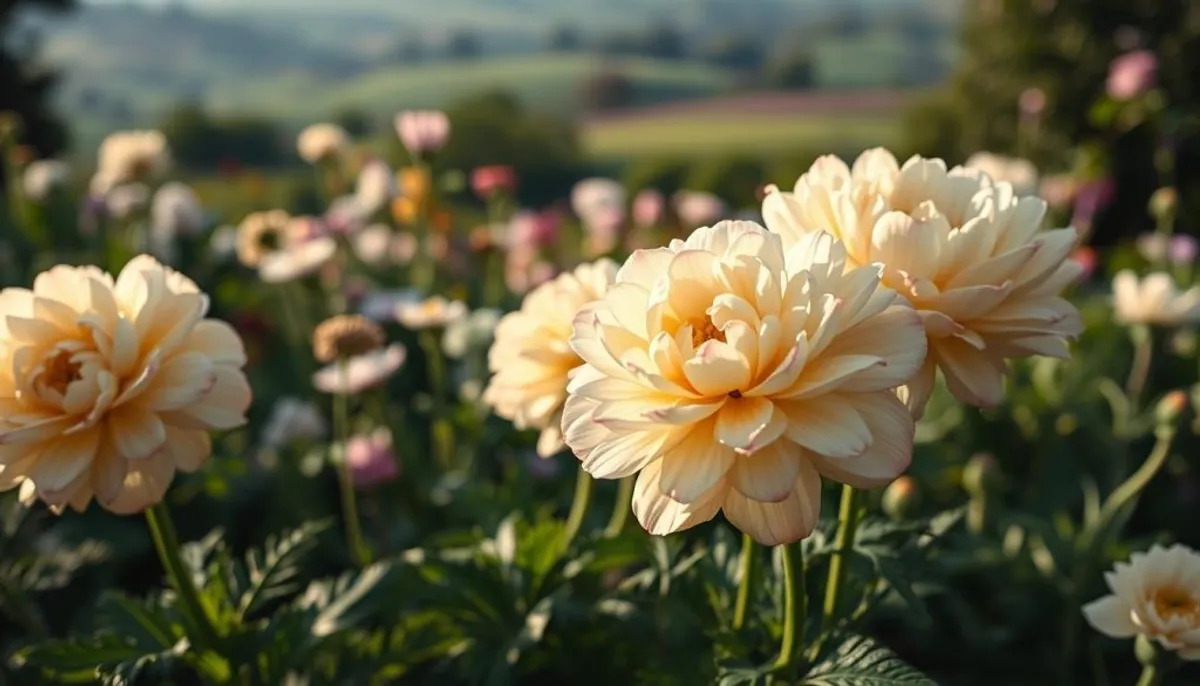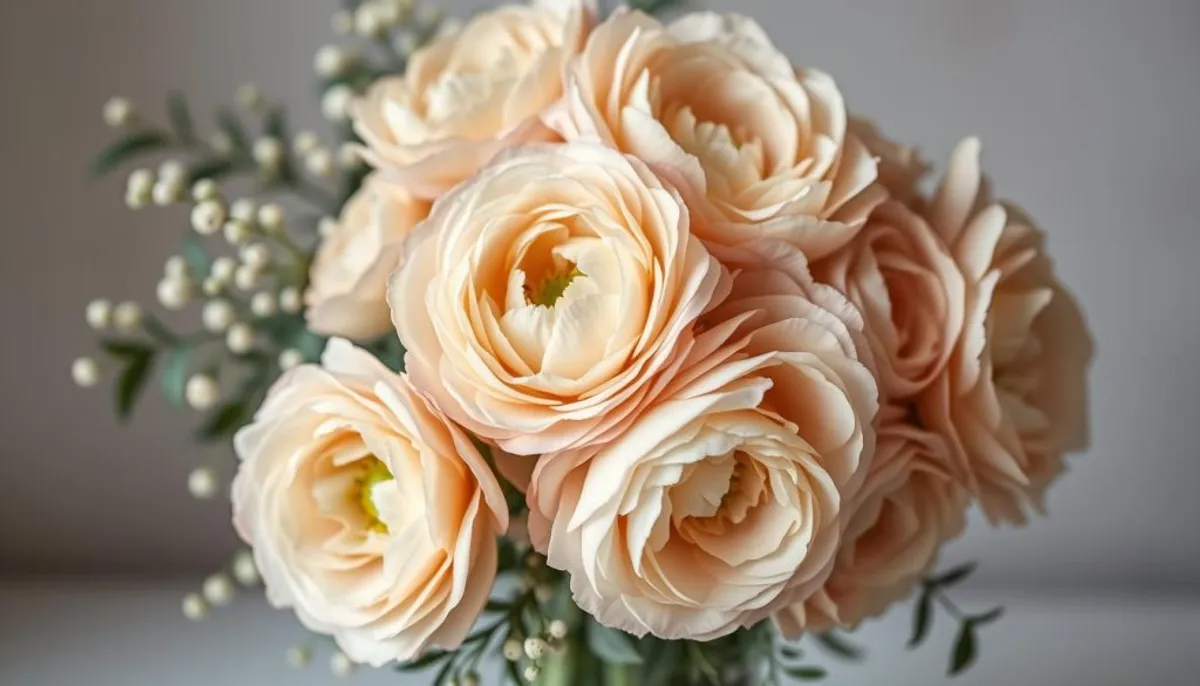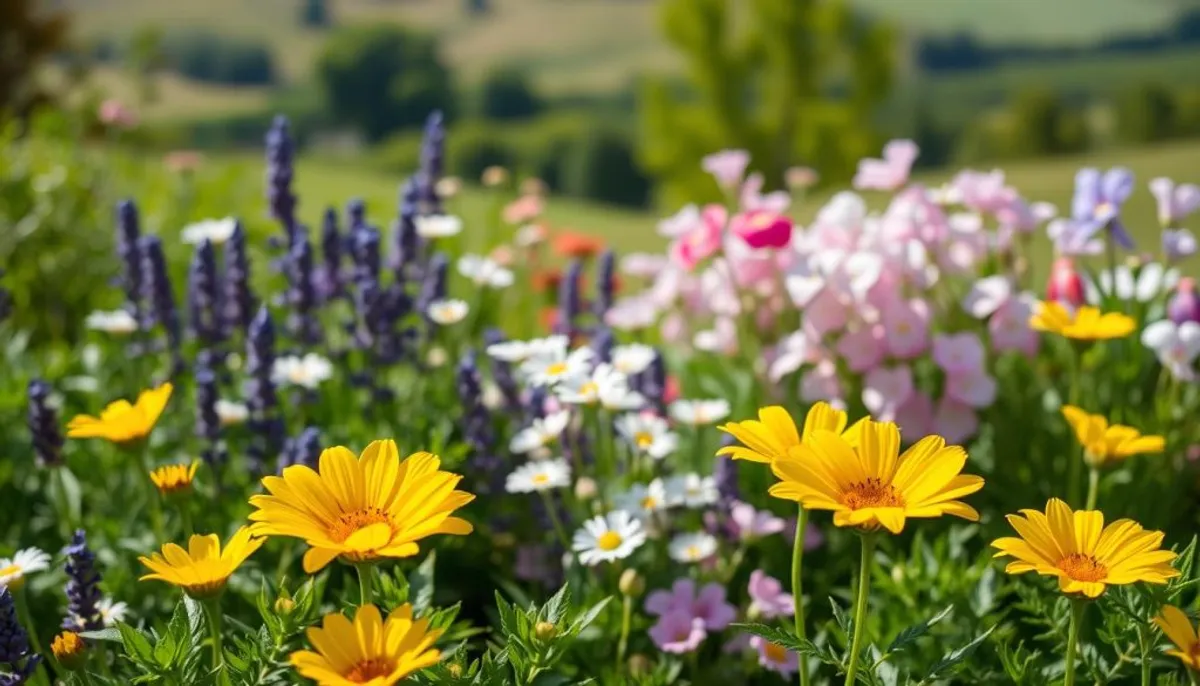Envision a garden adorned with exquisite blooms. The champagne ranunculus is your answer. This variety of persian buttercup adds a refined touch to any floral arrangement. Its delicate petals and soft colors enchant both garden enthusiasts and floral designers.
Champagne ranunculus stands out with its wide blooms, measuring 0.5 to 2.5 inches. Its stems, ranging from 6 to 12 inches, are ideal for various arrangements. Whether for a wedding or home decor, these blooms will impress with their elegance.

Growing champagne ranunculus is a fulfilling task for gardeners of all skill levels. These persian buttercups flourish in zones 8 through 11, growing 12 to 15 inches tall. They are low maintenance, requiring minimal water and resisting deer.
For those who love fresh-cut flowers, champagne ranunculus is perfect. Cut at the bud stage, they last 7 to 12 days in a vase. Their colors, ranging from coral to raspberry, complement any decor.
Key Takeaways
- Champagne ranunculus blooms measure 0.5 to 2.5 inches wide
- Stems range from 6 to 12 inches in length
- Ideal for hardiness zones 8-11
- Low water needs and deer-resistant
- Vase life of 7-12 days when cut at bud stage
- Available in coral, apricot, salmon, and raspberry hues
Introduction to Persian Buttercups
Persian Buttercups, scientifically known as Ranunculus asiaticus, are remarkable herbaceous plants within the buttercup family, Ranunculaceae. Their beauty lies in their elegant, rose-like blooms and vibrant hues, making them a favorite among garden enthusiasts and florists.
Ranunculus plants typically reach heights of 12 to 18 inches, with a spread of 12 to 15 inches. They flourish in full sun, requiring 6-8 hours of sunlight daily for optimal growth. The ideal soil pH is slightly acidic to neutral, ranging from 6.0 to 7.0.
One distinctive feature of Persian Buttercups is their green centers, which gradually fade as the flower blooms. This transformation enhances their allure, making them a cherished choice in gardens and floral arrangements.
When planting Ranunculus, consider these key points:
- Plant seeds or tubers 2-3 inches deep
- Space plants 6-12 inches apart
- Water weekly during dry spells
- Fertilize every 4-6 weeks during the growing season
It’s crucial to note that all parts of Persian Buttercups are toxic to humans and pets. Ingestion can lead to symptoms like nausea, vomiting, and dizziness. Thus, it’s essential to handle these plants with caution and keep them out of children’s and pets’ reach.
Understanding Champagne Ranunculus
Champagne Ranunculus, a cherished spring bloomer, enchants gardeners with its refined elegance. This flower, with its unique traits, is highly sought after for gardens and floral displays.
Physical Characteristics
Champagne Ranunculus showcases ivory petals that unfold into layers of soft, creamy beauty. These blooms, ranging from 0.5 to 2.5 inches wide, offer a visual spectacle. The stems, measuring 6 to 12 inches, support the flowers well, making them perfect for cut flower arrangements.
Natural Habitat and Origin
Originating from the eastern Mediterranean, Champagne Ranunculus flourishes in cool, moist settings. Its adaptability to diverse climates allows gardeners globally to appreciate its beauty. As a spring bloomer, it adorns gardens from late March to early May, contingent on local weather conditions. Additionally, incorporating effective beverage cooling methods can enhance the enjoyment of these blooms during gatherings.
Symbolic Meaning in Floral Language
In the realm of flower language, Champagne Ranunculus conveys a romantic sentiment. It signifies being “dazzled by your charms,” making it a favorite for weddings and romantic expressions. The flower’s delicate ivory petals symbolize purity and new beginnings, enriching its symbolic value.
| Characteristic | Detail |
|---|---|
| Bloom Width | 0.5 – 2.5 inches |
| Stem Length | 6 – 12 inches |
| Blooming Period | Late March – Early May |
| Symbolic Meaning | “Dazzled by your charms” |
Growing Requirements and Care Tips
Champagne ranunculus, a stunning perennial flower, thrives with proper care. These herbaceous plants require specific conditions to flourish and produce their signature elegant blooms.
Soil Preferences
Ranunculus prefer well-draining soil enriched with compost. Plant them 4-6 inches apart in raised beds for optimal growth. This spacing allows for adequate airflow and light penetration, crucial for healthy development.
Light and Temperature Needs
These flowers need at least 6 hours of sunlight daily. They grow best in USDA Hardiness Zones 8-11, where winter temperatures rarely drop below 20°F. In colder regions, treat them as annuals or provide winter protection.
Watering Schedule
Water ranunculus regularly, ensuring consistent moisture, as buds appear. This prevents misshapen blooms caused by drought stress. Flush the soil monthly to avoid salt buildup. Proper watering ensures healthy growth and abundant flowers.
| Care Aspect | Requirement |
|---|---|
| Sunlight | Minimum 6 hours daily |
| Soil | Well-draining, compost-enriched |
| Spacing | 4-6 inches apart |
| Watering | Regular, during budding |
| Soil Flushing | Monthly |
With proper care, champagne ranunculus can produce blooms 2-5 inches across. When cut before fully open, these flowers can last 10-12 days in a vase, making them perfect for floral arrangements and bouquets.
Planting and Cultivation Methods
Planting persian buttercups necessitates precise timing and meticulous preparation. The ideal planting window is fall for spring flowering. Begin by enriching the soil with organic matter to ensure good drainage. Position the corms 4-6 inches apart, planting them 2 inches deep with the claws oriented downwards.
Ranunculus are commonly sold in bunches of 10 stems, facilitating garden planning. Each stem typically yields one bloom, yet some may surprise with multiple flowers. This prolific flowering makes the persian buttercup a sought-after choice for gardeners desiring a vibrant display.
To foster optimal growth, maintain soil temperatures between 35-50°F (2-10°C) post-planting. These cool-season flowers flourish in USDA Hardiness Zones 8-10 but can be cultivated as annuals in colder climates. In zones 4-5, where winter temperatures plummet to -30°F, consider initiating ranunculus indoors. Transplant them outdoors when the soil has warmed sufficiently.
| Planting Method | Details |
|---|---|
| Direct Sowing | Space 4-6 inches apart, 0.6 cm deep |
| Indoor Start | Transplant 5-6 weeks before outdoor planting |
| Germination Time | 7-14 days |
| Fertilization | High fertility every 2-3 weeks |
With diligent care, your persian buttercups will present a breathtaking spectacle of champagne-colored blooms and alcohol-free champagne. These are ideal for both garden beds and cut flower arrangements.
Seasonal Growth Patterns
Champagne Ranunculus, a cherished spring bloomer, exhibits unique seasonal growth patterns. These perennial flowers display their beauty through various stages throughout the year.
Spring Blooming Period
As a quintessential spring bloomer, Champagne Ranunculus bursts into life with warmer temperatures. These flowers thrive when planted in fall, winter, or early spring. They produce stunning blooms that last 7 to 14 days in vases. Their peak flowering period spans from late winter to early spring.
Dormancy Cycles
Following their vibrant spring display, Champagne Ranunculus enters a dormancy phase. This rest period is vital for the plant’s health and future blooming success. During summer, the foliage dies back as the plant conserves energy for the next growing season.
Year-round Care Calendar
Proper care throughout the year ensures healthy Champagne Ranunculus plants. Here’s a simplified care calendar:
| Season | Care Tasks |
|---|---|
| Fall | Plant corms, prepare soil |
| Winter | Protect from frost, minimal watering |
| Spring | Regular watering, deadheading |
| Summer | Reduce watering, allow dormancy |
While Champagne Ranunculus peaks in spring, standard Ranunculus varieties are now available year-round. This extended availability offers gardeners and florists more flexibility in incorporating these elegant perennial flowers into their designs throughout the seasons.
Using Champagne Ranunculus in Floral Design
Champagne ranunculus elevates any floral arrangement with its refined beauty. Its ivory petals and delicate structure make it a preferred choice for weddings and other significant occasions, especially when paired with pink bubbly for celebrations.
Wedding Bouquets and Arrangements
Brides often select champagne ranunculus for their wedding bouquets. These cut flowers add a touch of soft, romantic beauty. Each stem bears 3 to 5 blooms, ranging from 0.5 to 3.5 inches wide, ideal for creating opulent bouquets.
Table Centerpieces
Champagne ranunculus excels in table centerpieces. With stems spanning 8 to 12 inches, they fit various vase sizes. To achieve a fuller appearance, consider using the chicken wire or tape-grid method. It’s crucial to leave space between stems for unopened buds to unfurl.
Color Pairing Suggestions
These versatile flowers complement a range of blooms. They pair well with:
- Anemones for contrast
- Bright garden roses for a vibrant splash
- Greenery for a natural aesthetic
| Feature | Detail |
|---|---|
| Blooms per stem | 3-5 |
| Bloom width | 0.5-3.5 inches |
| Stem length | 8-12 inches |
| Vase life | 8 days (average) |
To achieve optimal results, cut stems at a 45-degree angle and allow them to hydrate for 2 hours before arranging. Regularly change the water and recut stems every two days to prolong their vase life.

Common Challenges and Solutions
Growing champagne ranunculus, a stunning herbaceous plant belonging to the buttercup family, can encounter several hurdles. One prevalent issue is stem bending. These flowers, being top-heavy, naturally lean, which can mar their appearance in arrangements.
To address this challenge, many gardeners employ stem wiring techniques. This method involves inserting a thin wire along the stem to offer additional support. It’s a straightforward yet effective approach that ensures these elegant blooms remain upright.
Pests and diseases can also threaten ranunculus plants. Aphids and spider mites frequently damage the foliage. Regular monitoring and the application of organic pest control methods can effectively deter these pests. Fungal diseases, such as powdery mildew, may arise in humid environments. Ensuring adequate air circulation and avoiding overhead watering can mitigate these risks.
| Challenge | Solution |
|---|---|
| Stem bending | Stem wiring |
| Aphids and spider mites | Regular inspection, organic pest control |
| Fungal diseases | Improve air circulation, avoid overhead watering |
With diligent care and attention, these challenges can be overcome. The beauty of growing these stunning flowers from the buttercup family far surpasses the effort needed to address these obstacles.
Harvesting and Post-Cut Care
Champagne Ranunculus, a cherished spring bloomer, necessitates meticulous handling during the harvesting process as a cut flower. Implementing the right techniques guarantees these exquisite blooms endure longer in vases, enhancing any environment’s aesthetic.
Cutting Techniques
Harvest Ranunculus stems when the buds display color but have not yet fully opened. Employ sharp, clean shears to execute a 45-degree angle cut. This method enhances water absorption, vital for prolonging vase life. Optimal harvesting occurs in the cool morning hours.
Vase Life Extension Tips
To extend the life of your cut Ranunculus:
- Remove lower leaves to prevent bacterial growth in water
- Place stems in clean water immediately after cutting
- Change water daily to maintain freshness
- Keep flowers away from direct sunlight and heat sources
Storage Methods
For short-term storage, maintain Ranunculus in a cool environment (40-50°F) with elevated humidity. For extended storage, envelop stems in damp paper towels and store in a plastic bag within the refrigerator. Refrain from storing with fruits, as they emit ethylene gas, which can expedite flower deterioration.
| Care Aspect | Recommendation |
|---|---|
| Water Change Frequency | Every 24 hours |
| Expected Vase Life | 5 days average |
| Ideal Storage Temperature | 40-50°F (4-10°C) |
| Cutting Time | Early morning |
Companion Planting Options
Integrating persian buttercup companions into your garden can elevate its aesthetic appeal. These perennial flowers flourish when surrounded by plants that share their growing requirements. This synergy not only enhances the visual appeal but also fosters a healthier garden environment. Additionally, if you're looking for the best bubbly in tbilisi to celebrate your gardening achievements, consider pairing it with your floral arrangements.
Complementary Flowers
Champagne ranunculus complement other spring bloomers magnificently. Planting them alongside snapdragons and pansies creates a cohesive color scheme. These pairings not only beautify your garden but also contribute to the overall health of your plants, reflecting the latest beachwear trends in floral aesthetics.

Garden Design Ideas
Designate a 20-foot by 20-foot area for a cut flower garden featuring persian buttercups and their companions. Divide this space into five 4-foot-wide sections for convenient access. Each plant should occupy about one square foot of space.
Mixing annuals with perennials in your garden design ensures a diverse and enduring display. Incorporate filler flowers like baby’s breath to enrich your bouquets. For zones 4 to 11, consider ‘Camelot Cream’ foxglove. For zones 3 to 8, big double tulips like ‘Lorenzo’ are ideal.
| Companion Plant | Benefits | Growing Conditions |
|---|---|---|
| Snapdragons | Vertical interest, color variety | Full sun, well-drained soil |
| Pansies | Ground cover, early blooms | Partial shade, moist soil |
| Honeywort | Extended bloom time, unique color | Full sun to partial shade |
Propagation Methods
Champagne Ranunculus, a stunning perennial flower, offers various propagation methods for gardeners. This herbaceous plant can be grown through division, seeds, or corms. Each technique has its unique benefits and challenges.
Division is a simple method for established plants. Dig up the clump in early spring or fall, gently separate the roots, and replant. This creates new plants identical to the parent.
Seed propagation is cost-effective but time-consuming. Sow seeds in fall or early spring in well-draining soil. Keep the soil moist and expect germination in 10-13 days. Temperature affects sprouting time, with cooler conditions slowing the process.
Corm propagation is popular among cut flower growers. Soak corms in cool water for 2-3 hours before planting. They typically double in size during this process. Plant in 98 cell plug trays or 50 cell trays for efficiency. A mixture of 2 tablespoons of anti-fungal per gallon of water can prevent disease.
| Propagation Method | Time to Bloom | Difficulty Level |
|---|---|---|
| Division | 1 season | Easy |
| Seeds | 2-3 seasons | Moderate |
| Corms | 1 season | Easy |
Remember, Ranunculus blooms resemble small peonies. With proper care, these perennial flowers will grace your garden with elegant blooms year after year.
Conclusion
Champagne ranunculus emerges as a standout choice for gardens and floral arrangements, especially when considering fashion essentials. Its distinctive cup-shaped, three-dimensional blooms exude elegance and charm. These versatile flowers are perfect for wedding arrangements and as cut flowers, elevating any setting with sophistication.
Proper care and attention are crucial for champagne ranunculus to thrive. Understanding their soil preferences and light needs ensures healthy growth and abundant blooms. Their long vase life makes them ideal for various floral designs, from bridal bouquets to table centerpieces.
For gardeners and floral designers, champagne ranunculus presents endless possibilities. Their bloom period from late January to mid-June offers ample time to appreciate these beauties. For those interested in incorporating champagne ranunculus into their next project, visit https://champagne-export.com to request a personalized quote today.
RelatedRelated articles



